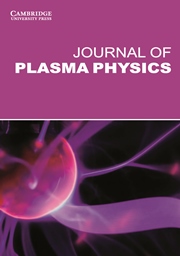Article contents
The scaling of collisionless magnetic reconnection in an electron–positron plasma with non-scalar pressure
Published online by Cambridge University Press: 20 December 2012
Abstract
Collisionless magnetic reconnection via tearing instability in non-relativistic electron–positron (pair) plasma with an anisotropic pressure is investigated. The equilibrium magnetic field is considered to be sheared force-free, and a set of linearized collisionless Magnetohydrodynamics equations describes the evolution of reconnection dynamics. A linear analytical analysis, based on scaling, demonstrates that in such a pair plasma, breaking the frozen in flow constraint for field lines can be mainly provided by the non-gyrotropic pressure of electrons and positrons (rather than the particle bulk inertia) when the current sheet width is smaller than the particle Larmor radius (Δx < rL). This condition is satisfied when β > d2 (d = c/ωp is the particle skin-depth with the electron/positron frequency ωp and β = 8πP(0)/B02 ⪡ 1). Meanwhile, on top of the Lorentz force and in the absence of the reconnection facilitating mechanism of the Hall effect, non-scalar pressure force can accelerate bulk plasma into the diffusion region at the scale lengths of the order of dx. Therefore, the respective regime of tearing instability proceeds much faster compared with the case of an isotropic pressure with a new dimensionless growth rate of (γτA) ~ d.
Information
- Type
- Papers
- Information
- Copyright
- Copyright © Cambridge University Press 2012
References
- 1
- Cited by

